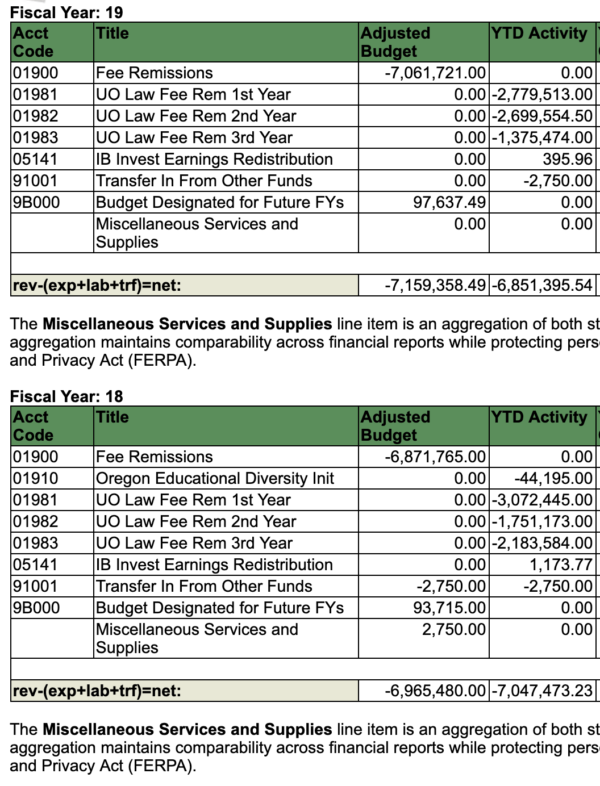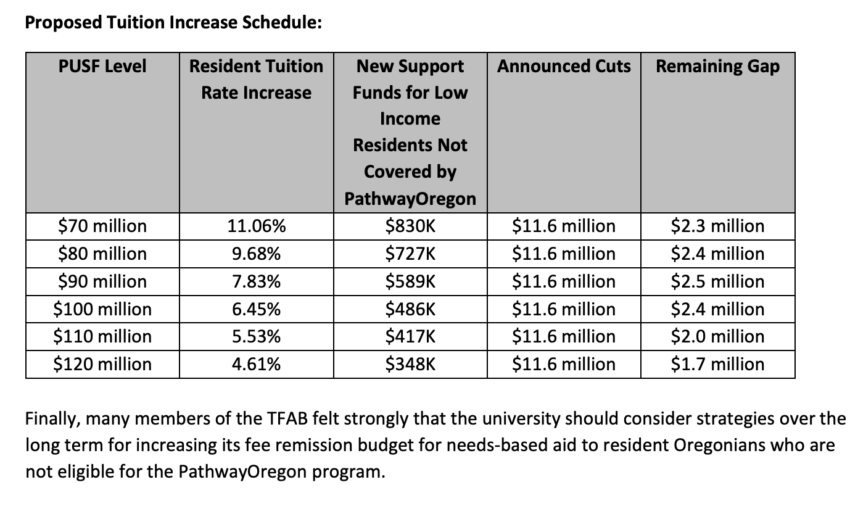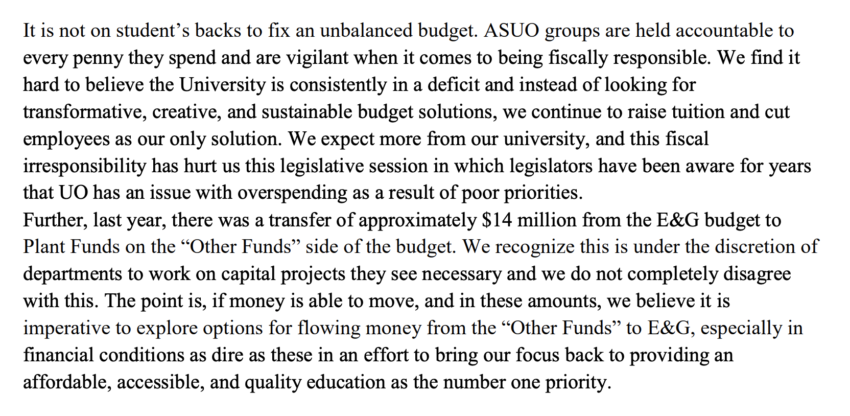6/7/2019 update: Legislature to add ~$100M to PUSF, Gov Brown wants more
That’s the rumor today. According to Pres Schill’s proposal below, $120M would keep UO’s tuition increase below the 5% trigger for HECC review, and also save Duck AD Rob Mullens a couple hundred large to help pay for his new baseball coach.
5/20/2019 update: Update: Millions from staff and students, not a cent from Duck athletics or Law
President Schill has sent his tuition increase recommendations to the BOT, below. His proposal cuts TFAB’s support for low income students, keeps the LERC and museum cuts, and leaves athletic subsidies untouched. The TFAB’s proposal was for a progressive increase in financial aid as tuition increased. Pres Schill’s recommendation is for only $350K in new financial aid, and that only if the tuition increase goes above 5%, the level which triggers HECC review.
Meanwhile, the “temporary” budget funding for law school scholarships increases by $190K. Of the $44M in fee remissions President Schill mentions below, $7M or goes to UO’s ~410 law school students, for an average of $17,100 each, per year. (I don’t know how it’s split up). The other $37M is divided among UO’s 22,350 other students, for an average of $1,650.

5/20/2019 Letter from Pres Schill:
|
To University of Oregon community members,
Over the last week, I have received in-person and online input from students and other campus stakeholders on the 2019–20 resident undergraduate tuition recommendation from the Tuition and Fee Advisory Board (TFAB). I greatly appreciated hearing from students at the open forum, and I want to thank everyone who invested the time to share their point of view. I have considered all of your advice and suggestions, which helped influence my thinking on this matter. My recommendation to the Board of Trustees is slightly modified from that presented by TFAB.
Resident tuition rates closely correlate to the level of support provided by the state of Oregon. However, we may not have certainty about where state support will net out until late June or early July. Therefore, I am asking the Board to consider a proposal that would index the UO’s tuition rate for resident undergraduates to potential state funding levels. Unfortunately, that means proposing tuition levels that exceed 5 percent, something I had hoped we would not have to do. Any tuition increase over 5 percent must be approved by the state’s Higher Education Coordinating Commission.
In the last few days, we have seen a positive state revenue forecast and heard optimistic rumblings from lawmakers regarding the prospects for a boost to statewide higher education funding. For that reason, I am eliminating any recommendation for a tuition rate increase over 10 percent. As I and many others have repeated for months, the University of Oregon has joined with all of the public universities in the state in making the case that a minimum of a $120 million increase in funding for higher education is needed to broadly maintain our current level of service for students and to keep this year’s tuition increase at or below 5 percent. I also departed from TFAB’s recommendation by adjusting the lowest possible tuition rate down to 4.45 percent, which is dependent on receiving the full additional $120 million in the state’s Public University Support Fund (PUSF). My recommended tuition schedule is:
|
|
|
Of course, there is risk built in my decision to recommend a top rate of 9.68 percent. As TFAB recognized in its recommendation, it is possible that the state will allocate less than $80 million to the PUSF, which means that we would encounter a greater shortfall in funding in 2019-20 than planned. I believe that this is a risk worth taking because I and the trustees find a tuition increase over 10 percent to be too burdensome for our students. However, if the legislature fails to allocate $80 million to the PUSF this year, we will need to increase our tuition next year to incorporate this shortfall, even if that would cause tuition rate increases to exceed 5 percent again.
Regardless of where the tuition rate settles out, I am worried about the impact on our institution’s most vulnerable students. The UO currently allocates about $44 million annually to fee remissions, including support for the PathwayOregon program, which provides full tuition and fees to academically qualified, Pell Grant-eligible residents who start as first-year students on our campus. In fact, almost one-in-four of our in-state residents receive the PathwayOregon benefit already, and they will be protected from the impact of rising tuition regardless of the percent increase. If the tuition rate increase exceeds 5 percent, however, I will set aside up to $350,000 in new dollars for grants for low-income students who are not supported by Pathway. Even with the proposed resident undergraduate tuition increase, the UO will still face considerable budget challenges. For this reason, we need to move forward with our plans to reduce general fund budgets and expenditures by $11.6 million. We are doing everything possible to ensure that the reductions in our schools and colleges have as little negative impact as possible on academic activities and programs including career faculty and staff members, as well as critical student support services.
Due to a perfect storm of uncertainty around state funding and other budget challenges, this has been an incredibly difficult year in terms of setting tuition. I hate that we must consider tuition rate increases above 5 percent and I will continue to work until the end of the legislative session to make the case that lawmakers need to provide a level of support that would not unduly burden resident students. Our economy is seeing unprecedented growth, and our state’s students and families deserve better.
Despite the budget constraints, I remain optimistic and dedicated to preserving and advancing the progress we have made over the last few years. We are continuing to enhance excellence in teaching, research, and support for student access and success programs. As I have said previously, even though we are in a challenging period, the hurdles we face are not insurmountable. Even in the face of adversity, we must remain vigilant in our pursuit of excellence in all that we do at the UO.
Thank you.
Michael H. Schill
President and Professor of Law
|
|
5/13/2019 update:
That’s the takeaway from tonight’s town hall event with President Schill. Say what you will about failed one-term President John Adams, but at least he knew how to deal with extortion: Send in the Navy.
5/13/2019: Pres Schill to answer student questions about tuition increases
The Town Hall is 6PM tonight in the EMU Ballroom.
The process leading up to this year’s tuition increases started with the decision by the administration to wall off large parts of the budget from debate and cuts. Duck athletics, whose budget has swollen from $98M in 2014-15 to $121M in 2018-19 is and includes about $5M in subsidies from the general fund, is the most obvious example. We were told Duck athletics would not share in UO’s budget cuts, nor would police, or the new Tykeson advising plan. Non-negotiable.
Non-resident student tuition was set to 2.9% early in the process. This left the university’s academic units – starting with the museums, Bach and LERC and extending to most academic units except Knight Campus – to take the hits, and undergraduate tuition to make up any remaining shortfalls.
Given those early decisions, the TFAB’s tuition recommendation process was reduced to making guesses about enrollment and state funding and then seeing how much tuition needed to be increased to balance the budget. The forecast for new enrollment came in mixed – a decline in in-state students, and an increase in non-resident students that will, however, barely offset the losses as the current bulge graduates, and given the 2.9% tuition increase will yield less revenue that it could have, given the inelasticity of demand.
The math worked out to tuition increases in the 8-11% range – more if the state sticks to its original budget. UO has consistently failed in convincing the legislature that we are good stewards of the state’s money.
The TFAB report is here:

The ASUO student government made a minority report (same link, starts on page 5):





Not possible to make sense of the table posted by UOM from the long TFAB report. What is the “PUSF level”? I assume it has something to do with the subsidy to UO from the state. But surely it is not equal to said subsidy — the % tuition increases would make absolutely no sense at all. So I am (somewhat) lost.
An 8% tuition increase for in-state would bring in roughly $5 million more than a 4% increase, net of likely financial aid increases.
Interestingly, the figure I have heard for the cost of the new Tykeson hires is $5 million/year.
I wonder what the students would say if asked whether they think it is worth it to have an 8% tuition increase rather than 4%, so they can have access to more advisers in the new Tykeson center.
Oregon State reportedly has decided on a 4.3% tuition increase. If UO really tries to grab 8%, it is going to look awful. If I were in the Legislature, I would tell UO to go to hell.
As I’ve said elsewhere, UO seems to be afflicted with white elephants it has taken on — the new Tykeson center (new advising costs), the Knight campus (which reportedly is sucking fundraising away from existing units). Expensive new trophies that UO can’t afford.
Now the budget situation is being used to demand a huge tuition increase which I think is going to explode in UO’s face — I don’t think the Legislature is going to say “Oh, we’d better bail you out this time.”
Something seems to be very wrong in Johnson Hall.
Yup.
*PUSF Public Universities Support Fund. is HECC speak for the dollars the state gives to the 7 universities plus tuition and other…
https://www.oregon.gov/highered/research/Pages/ARB.aspx
I went to the Monday evening Q&A but could only stay half an hour, hence left in the middle of VPAA Moffitt’s framing presentation (subtitle: why we have no choice at all but to raise tuition and make draconian cuts).
I took a copy of the May 10th, 2019 follow-up memo to Pres Schill from the co-chairs of TFAB, and the undated FAQ sheet, which were on the tables. Happy to share
I can’t imagine being an incoming freshman and my family finding out that tuition is 8% (or more) higher than I budgeted! Price being an important factor some people may have accepted with a good faith belief that tuition would not go up more than a few percentages. Not a great way to start out.
Any reports on how the meeting went, level of attendance etc? Nothing on the daily emerald site either. . .